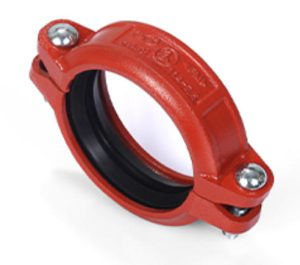
When you’re putting together a piping system—whether it’s for HVAC, fire protection, or an industrial setup—every choice matters. It’s not just about what gets the job done. It’s about what gets it done without draining your budget. Grooved couplings, welding, and flange are three common ways to join pipes. But which one keeps more money in your pocket? Let’s break down the costs of grooved couplings compared to welding and flange. We’ll look at why grooved systems, like those from Vicast, might be the smartest pick for your next project.
Understanding Pipe Joining Methods
Before we dive into the numbers, let’s get clear on what these methods involve. Each has its strengths, but they come with different costs and practical trade-offs.
Grooved Couplings: The Basics
Grooved couplings, such as the Vicast® XGQT13 Adaptor Flange or XGQT15S Mechanical Tee, use a mechanical system to connect pipes. A groove is cut or rolled into the pipe ends. Then, a coupling with a gasket and bolts clamps them together. It’s fast and secure. These couplings are built to handle tough conditions—temperatures from -20°F to +180°F (-29°C to +82°C) and sizes from 1” to 12” (DN25 to DN300). They meet standards like ISO6182 and AWWA C606.
Welding: The Traditional Heavyweight
Welding fuses pipes with heat to create a permanent bond. It’s been a go-to method for years, especially in high-pressure systems. But it’s not simple. Welding demands skilled labor, specialized gear, and plenty of time. It’s also messy—think fumes, sparks, and safety hazards that you can’t ignore.
Flange: The Bolt-and-Nut Approach
Flange uses bolted flanges to join pipes, often with a gasket for sealing. It’s great for systems that need occasional disassembly. But flanges are bulky. Installing them can feel like wrestling a puzzle under tight deadlines. Like welding, it requires precision and patience.
Breaking Down the Costs
Now, let’s talk money. We’ll compare grooved couplings, welding, and flange across materials, labor, installation time, maintenance, and long-term durability. I’ve pulled insights from industry practices and real-world projects to keep this real.
Material Costs
For grooved couplings, you’re paying for the coupling itself, like the Vicast® XGQT13 or XGQT18 Mechanical Cross, plus gaskets and bolts. For a 4” pipe, a single coupling might cost $20 to $50, depending on the pressure rating (say, 225 Psi or 363 Psi for adaptors). You’ll need to groove the pipes, but that’s a one-time tool cost if you’re not outsourcing. Welding, on the other hand, involves welding rods, shielding gas, and sometimes filler materials. For a 4” steel pipe, consumables run $10 to $20 per joint. But don’t forget the welding rig—$5,000 to $10,000 if you’re buying, or rental fees if you’re not. Flange is pricier still. A 4” flange can set you back $30 to $100, plus $5 to $15 for bolts and gaskets. If you’re dealing with high-pressure or specialty materials, those costs skyrocket.
Table 1: Material Cost Comparison (4” Pipe, Single Joint)
| Method | Material Cost (USD) | Notes |
| Grooved Coupling | $20–$50 | Includes coupling, gasket, bolts |
| Welding | $10–$20 | Excludes equipment purchase/rental |
| Flange | $35–$115 | Includes flange, bolts, gasket |
Labor Costs
Labor is where the real differences show up. It’s often the biggest slice of any piping project’s budget. Grooved couplings have a clear advantage here. Installing one is quick—think 5 to 10 minutes with basic tools like a wrench or a grooving machine. At a labor rate of $50 an hour, that’s $4 to $8 per joint. You don’t need a certified pro, so you’re not shelling out for specialized skills. Welding, though, is a different story. A skilled welder, earning $60 to $100 an hour because of certifications, might take 20 to 30 minutes per joint, including prep and cleanup. That’s $20 to $50 per joint, and if the job drags into overtime, costs climb fast. flange sits in the middle. It takes 15 to 20 minutes per joint, factoring in alignment and bolting. At $50 an hour, you’re looking at $12 to $17 per joint. But if alignment goes off, you’re stuck burning time and money.
Installation Time and Project Timelines
Time is money, especially when delays mean lost revenue. Grooved couplings are a time-saver. A small crew can install dozens of couplings in a day. For a 100-joint HVAC system, you could be done in 1 to 2 days. The process is straightforward, so you need fewer people and less downtime. Welding, by contrast, is slow. That same 100-joint system might take 4 to 5 days, assuming no rework for bad welds (which, let’s be honest, happens more than anyone likes to admit). You also have to factor in setup and safety checks. Flange is faster than welding but slower than grooving. Expect 2 to 3 days for those 100 joints, with extra time for getting the alignment just right.
Take this real-world case: a fire protection system for a mid-sized commercial building with 200 joints. Using Vicast® XGQT18 Mechanical Crosses, the job was done in 3 days with grooved couplings. A competitor using welding took 7 days for a similar setup. Their labor costs ate up a chunk of the budget, and the client wasn’t thrilled about the extra downtime.
Maintenance and Long-Term Costs
Piping systems need upkeep. Maintenance costs can creep up if you’re not careful. With grooved couplings, maintenance is minimal. The gasket might need replacing every 5 to 10 years, costing $5 to $10 per joint. If a pipe needs swapping, you just unbolt the coupling—no cutting or grinding required. Grooved systems also handle vibrations well, which means less wear over time. Welded joints are permanent, which sounds solid until you need to make a repair. Cutting out a bad section and re-welding can cost $50 to $100 per joint in labor alone. Plus, corrosion at weld points often means more frequent inspections. Flanges are easier to disassemble than welds, but their gaskets wear out faster—every 3 to 5 years. Replacing them costs $10 to $20 per joint. And if bolts corrode, you’re looking at unexpected expenses.
Hidden Costs: Safety and Downtime
There’s more to consider than just materials and labor. Welding comes with fire risks, fumes, and the need for safety gear. That means extra costs for training and equipment—$1,000 to $2,000 a year per welder, easily. Grooved couplings? You’re just tightening bolts. No sparks, no hazmat suits, no drama. Flange avoids welding’s hazards but still needs careful handling to prevent leaks. A bad flange joint can lead to downtime, and downtime is never cheap.
Why Grooved Couplings Often Come Out Ahead
When you add it all up, grooved couplings frequently save you money, especially when speed and flexibility are key. Labor costs are lower because you don’t need certified welders. Installation is faster, so your project stays on track. Maintenance is simpler—swapping a gasket beats cutting out a weld any day. Plus, grooved systems handle misalignment and vibrations better, which means fewer headaches down the road. For a 100-joint system with 4” pipes, grooved couplings might cost $2,400 to $5,800 total, compared to $3,000 to $7,000 for welding and $4,700 to $13,200 for flange. Those savings add up, especially on bigger jobs.
Table 2: Total Cost Estimate (100-Joint System, 4” Pipe)
| Method | Material Cost (USD) | Labor Cost (USD) | Total Cost (USD) | Installation Time |
| Grooved Coupling | $2,000–$5,000 | $400–$800 | $2,400–$5,800 | 1–2 days |
| Welding | $1,000–$2,000 | $2,000–$5,000 | $3,000–$7,000 | 4–5 days |
| Flange | $3,500–$11,500 | $1,200–$1,700 | $4,700–$13,200 | 2–3 days |
Note: Costs vary by region and project details. These are averages based on industry data.
A Quick Word on Quality
Saving money is great, but a cheap system that fails is no bargain. Grooved couplings, like Vicast’s XGQT06 Elbows or XGQT14 Split Flanges, are built to last. They meet tough standards like ASTM A536, ASTM A395, and ISO6182. I’ve seen projects where contractors tried to cut corners with low-quality welding to save a few bucks. The result? Leaks and rework that cost way more than they saved. High-quality materials and smart design, like what Vicast delivers, pay off over time. It’s not just about the upfront cost—it’s about avoiding headaches years down the line.
About Vicast: Your Grooved Pipe Fitting Supplier

Vicast has earned its stripes as a reliable supplier of grooved pipe fittings. Their products, from the XGQT13 Adaptor Flange to the XGQT15S Mechanical Tee, are designed for applications like HVAC, fire protection, and industrial systems. Built to standards like ISO6182 and AWWA C606, Vicast fittings come in sizes from 1” to 12” (DN25–DN300) and handle temperatures from -20°F to +180°F. They’re all about durability and ease of installation, which helps contractors keep projects on budget and on schedule. Want to see their full lineup? Head over to cnvicast.com.
Conclusion
When you weigh grooved couplings against welding and flange, the cost analysis paints a clear picture. Grooved systems often save you money while still delivering the reliability you need. They cut labor costs, speed up installation, and make maintenance a breeze. Whether you’re working on HVAC, fire protection, or an industrial project, grooved couplings—like those from Vicast—are a practical choice. Welding and flange have their place, but for most jobs, grooved systems offer the best value. Ready to make a smart move for your budget? Grooved couplings might just be the way to go.
FAQs
How do grooved couplings stack up against welding for cost savings?
Grooved couplings usually save you money by cutting down on labor and installation time. For a 100-joint system, you could pocket $1,000 to $2,000 compared to welding. The reason? Faster setup and no need for pricey certified welders.
Are grooved couplings as tough as welded joints?
You bet. Vicast’s XGQT18, for example, meets ASTM and ISO standards. It can handle pressures up to 363 Psi and temperatures from -20°F to +180°F. They’re plenty durable for most jobs and easier to fix when needed.
Can grooved couplings handle high-pressure systems?
Yes, they can. Take the Vicast XGQT13, rated at 363 Psi. It’s built for high-pressure setups like fire protection or industrial systems, making it a reliable choice.
Why are grooved couplings cheaper than flange?
Flanges use more expensive materials—think flanges, bolts, and gaskets—and take longer to install. Grooved couplings are simpler and faster, which means lower material and labor costs.
Do you need special tools for grooved couplings?
Not really. A wrench and maybe a grooving tool are enough. Compared to welding rigs or flange alignment tools, it’s a small investment, especially for big projects.





